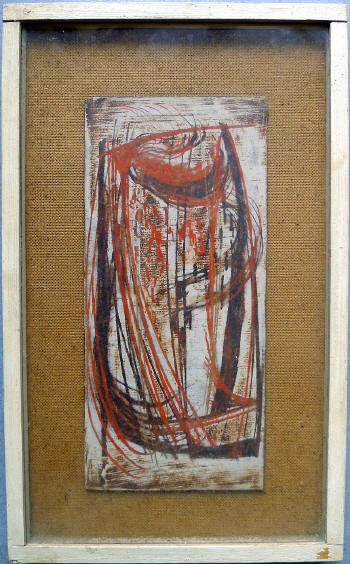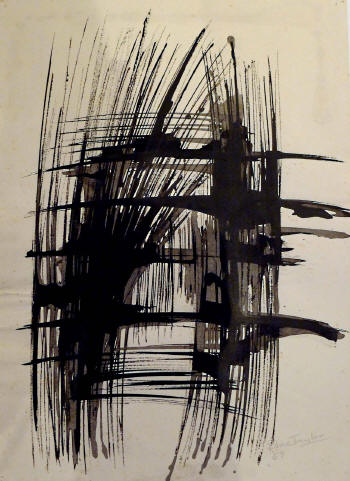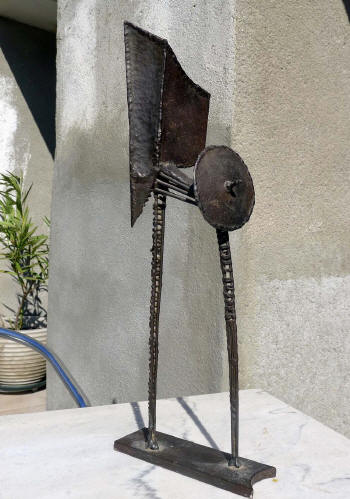|
|
| home | features | exhibitions | interviews | profiles | webprojects | gazetteer | links | archive | forum |
|
Bruce Taylor: A Lost Page Gerard Mermoz describes finding the works of a largely-forgotten St Ives artist in a car-boot sale in France.
When during the 1980's and 90's opportunities arose, in the form of retrospective exhibitions (eg St Ives: 1939-64, Tate Gallery, 1985) and publications (eg St Ives Revisited: Innovators and followers, 1994), to re-assess the contribution made by St Ives artists to British Modernism, one artist slipped through the net and fell deep into the limbo of art history.
During the ten years he spent in St Ives, Taylor exhibited regularly alongside Barbara Hepworth, Peter Lanyon, Patrick Heron, Bernard Leach and others, and was the only artist to exhibit drawings, sculptures and ceramics in Arts Council touring exhibitions of St Ives artists. He also had solo and group shows at the Drian Gallery (London), Arnolfini (Bristol), etc., and was hailed as ‘one of the earliest serious artists to work in the medium of welded steel’. During his period in St Ives (1956-1965) Taylor produced what may have been a small, but original body of work — between figuration and abstraction — inspired by continental ideas (Bergson’s Vitalism) and developments in painting (Hans Hartung), sculpture (Rodin, Germaine Richier) and ceramics (Vallauris). His works failed to attract the attention of critics who lacked the intellectual sophistication to assess what they were about, polarized, as they were between ‘figuration’ and ‘abstraction’. Taylor seemed to have been born too late and have been delayed by war service before being able to study art to then benefit from the opportunities offered by the Festival of Britain, the Venice Biennale, the Battersea Park exhibitions etc. Taylor would have remained in limbo, had it not been for a chance encounter with his work, at a car boot sale, in the south of France, where I first came across one of his paintings, amidst ‘bric-à-brac’, a few years ago. Not knowing the artist, but wondering how work of such quality could end up at a ‘vide grenier’, I set out to investigate.
Two years later, I deciphered its enigmatic title, ‘Ore stream’, illegibly scribbled in pencil on the back, by cross-referencing it with the list of titles in the catalogue of Taylor’s first solo show at the Drian Gallery (London), in 1958 [sourced from an antiquarian book seller]. With the oil, I also bought a ceramic dish, signed B. Taylor, which, unlike the painting, did not look as if it had been made by an English potter, but bore stronger affinities with continental works (Vallauris?). A year later, I bought an untitled abstract ink drawing ‘Drawing for Sculpture’? (left), signed ‘Bruce Taylor’, dated 1959, strongly reminiscent, in its gestural mode, of the paintings of Hans Hartung, but evoking forms moving in three-dimensional space. Both painting and drawing hinted, by their forms, that they may have been the work of a sculptor. This was confirmed by a short biography, published on line, at http://issuu.com/powershift/docs/dictionary_t and by a reference to the sale of one of his sculptures in London. The sculpture (very probably ‘May-bug’, first exhibited in 1957 and 1958 at the Drian Gallery) was acquired in 1994, from the Affordable British Abstract Art exhibition, held at the Belgrave Gallery, in London, by the Paisnell Gallery, who, in turn, sold it to a private client.
Reference to purchases by local education authorities, in the UK, by MOMA, New York, and by private collectors, shows that Taylor did sell his works at exhibitions; although these are proving elusive to trace. Meanwhile, in France, I learnt from the person who had sold me his three works, that Bruce and Judy Taylor had moved to the small village of Taulis, near Céret, during the late 60s; where her father, then mayor, had helped them find a house. The Taylors spent the rest of their life in that house. Bruce probably reinvented himself as a painter and print-maker, and his wife Judy as a potter. Both are buried in the village cemetery. The last piece of work I have come across (on ebay, from a seller based in Céret), is a silk-screen print, dated 1968-70, titled ‘Corrida’, inscribed ‘artist proof’ and dedicated ‘to Judy’. When I bought the abstract drawing, Janine, who was selling the works for a cancer charity, told me that these were works that the artist, then his wife, had kept till they died. This gave them a special significance. The works consisted of finished and unfinished sculptures in welded steel (Sentinel), aluminium and bronze, photographs of plaster models for bronzes, and bronze casts. They also included a photographic portrait of the artist, standing by one of his larger pieces (stamped ‘St Ives Photo studio’ on the back - below left), and a remarkable photomontage, that, alone, would warrant Taylor a place in the history of British art.
The chance encounter with his work at a car boot sale and the opportunity to acquire the selection of works from his St Ives period (1956-1965), works that he kept till he died, has enabled me to gather, preserve and to present, here, a selection of works, and, more extensively, on line, at http://alostpageofbritishmodernism.blogspot.fr/ as part of an on-going project to rewrite Taylor into the history of St Ives and British Modernism. I would be most grateful for any further information and any material you may have, about Taylor and his work, regarding his period in in St Ives or before or after 1965, and elsewhere and thank you in anticipation.
|
|
|




